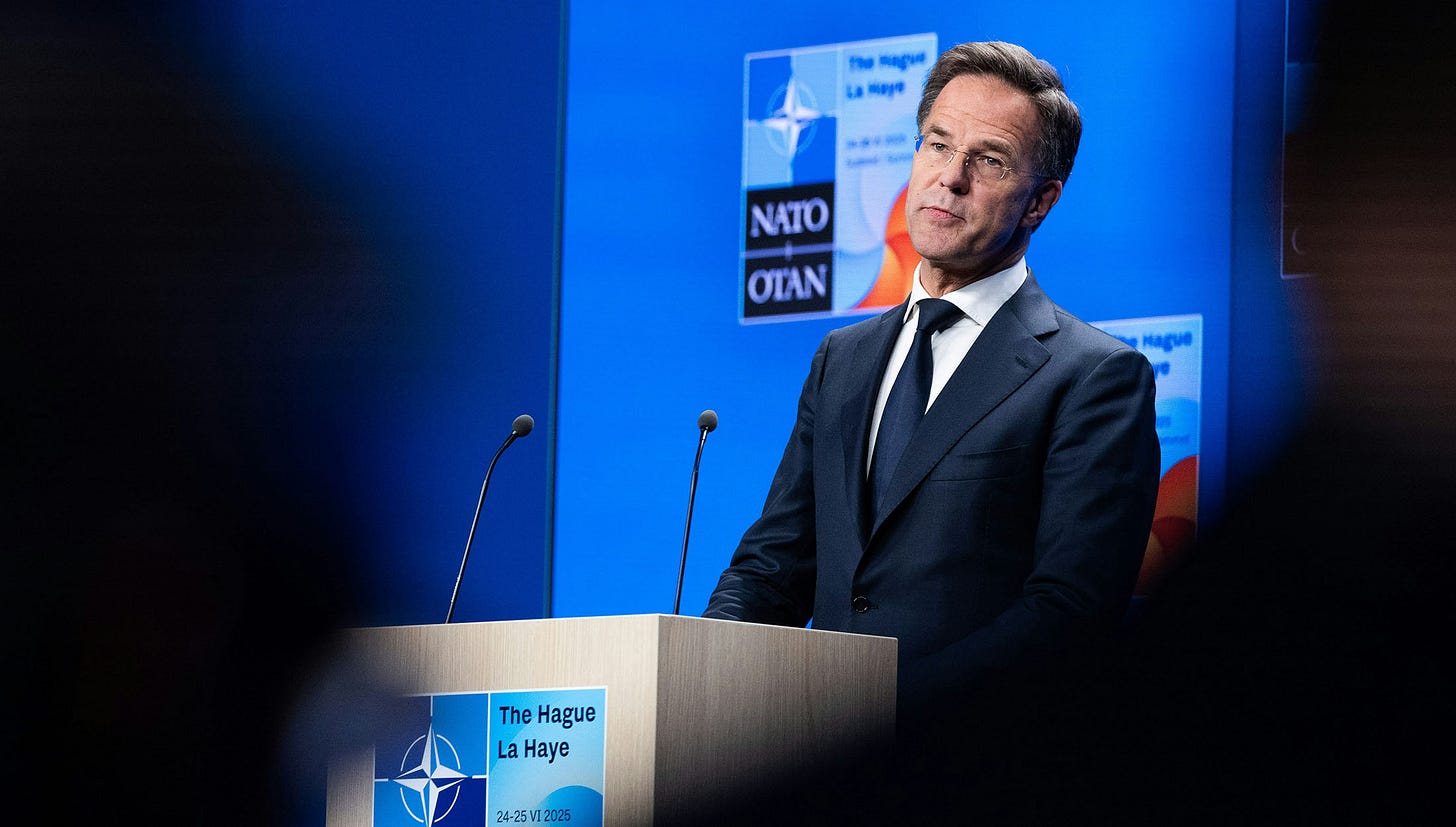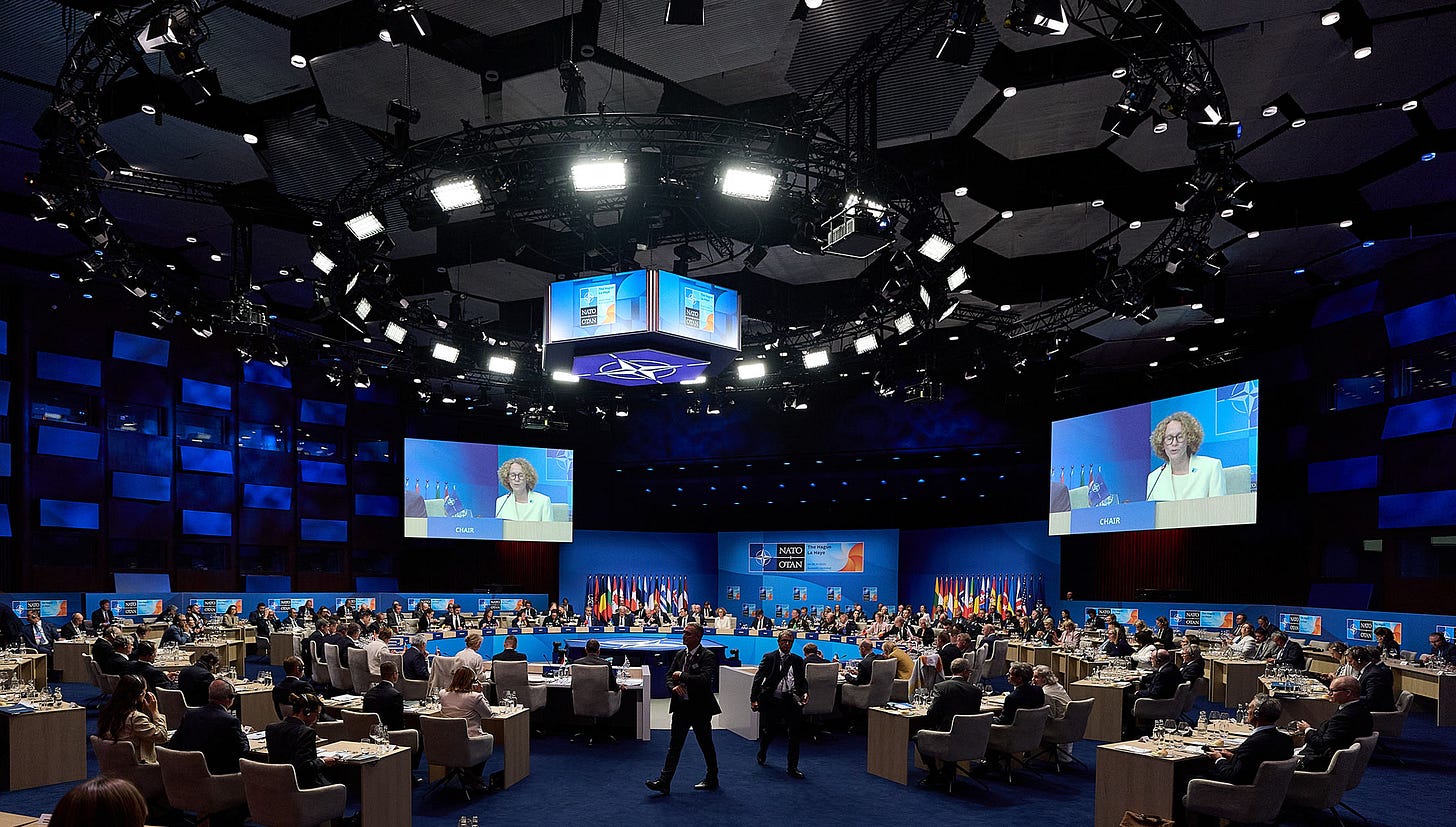NATO's AI Revolution Begins in a New Era of Defence Spending
The "Code Wars" are no longer hypothetical; they are here, and NATO is gearing up for the fight.
The year 2025 will be remembered as a pivotal moment for NATO security. At the NATO Summit in The Hague, the Alliance didn't just reaffirm commitments; it fundamentally reshaped its defence posture, signalling an unprecedented investment in capabilities, with technology at its core.
For anyone tracking the Code Wars—the escalating digital and algorithmic competition that defines modern power—this summit was a watershed moment.
Gone are the days of aspirational defence spending targets. The 2025 NATO Summit saw Allies commit to investing a staggering 5% of their Gross Domestic Product (GDP) annually on defence and security by 2035. This isn't just an increase; it's a strategic overhaul, driven by a stark recognition of evolving threats, particularly from an aggressive Russia and the pervasive nature of hybrid warfare.
This 5% commitment divides smartly, with 3.5% of GDP for core defence requirements—the traditional military might of weapons, personnel, and ammunition. The remaining 1.5% of GDP goes to the "digital home front"—protecting critical infrastructure, defending networks, enhancing civil preparedness, fostering innovation, and strengthening the defence industrial base.
This two-pronged approach acknowledges that modern conflict extends far beyond conventional battlefields. As newly appointed NATO Secretary General Mark Rutte aptly put it, the Alliance needs to "shift to a wartime mindset and turbocharge our defence production and defence spending". This financial muscle, coupled with explicit annual plans for achieving the goal, marks a new era of accountability and strategic intent. Even direct contributions to Ukraine's defence will now count towards these targets, underscoring the Alliance's united front against aggression.

The Alliance needs to shift to a wartime mindset and turbocharge our defence production and defence spending. ~ Mark Rutte, NATO Secretary General
Tech at the Forefront: Drones, Cyber, and AI Unleashed
This massive influx of funding will ignite a technological revolution within NATO. Emerging and Disruptive Technologies (EDTs)—particularly AI, autonomous systems (drones), and quantum computing—are no longer niche concepts; they are the future of collective defence.
NATO's strategy is clear: maintain a decisive technological edge.
This involves actively collaborating with the private sector and academia to harness dual-use technologies and innovations with both commercial and military applications. This fundamental shift recognises that cutting-edge breakthroughs often originate outside traditional defence contractors.
Key initiatives are already in motion to accelerate this transformation:
Rapid Adoption Action Plan (RAAP): Endorsed at The Hague, RAAP aims to slash the adoption time for new technologies into Allied forces to a maximum of 24 months. This is NATO's answer to historically sluggish procurement cycles, pushing for faster integration and de-risking investments through NATO-approved standards.
Defence Innovation Accelerator for the North Atlantic (DIANA): Launched in 2022, DIANA is a crucial bridge between deep-tech innovators and defence needs. It offers grants, access to over 20 accelerator sites and 180 test centres, and pathways to market for dual-use solutions.
NATO Innovation Fund (NIF): This €1 billion venture capital fund, the world's first multi-sovereign VC fund, provides patient capital to early-stage deep-tech startups addressing Alliance challenges. It's a clear signal that NATO stands ready to invest directly in the companies building the future of defence.
These initiatives underscore a critical evolution: NATO is not just buying technology; it's actively cultivating an innovation ecosystem designed to identify, test, and integrate cutting-edge solutions at unprecedented speeds.
AI's Core Role: Decision Superiority and Ethical Challenges
The most tangible sign of NATO's AI leap came on 25 March 2025, with the formal acquisition of the Maven Smart System NATO (MSS NATO). Developed by Palantir Technologies, MSS NATO is an AI-based warfare platform designed to achieve decision superiority.
This system automates intelligence fusion, cross-analysing vast streams of data from sensors, satellites, and human reports to create a real-time, comprehensive tactical picture. Leveraging large language models and machine learning, it enhances situational awareness, optimises operational planning, and dramatically accelerates decision-making. Its flexible architecture means it can host additional AI capabilities for modelling and simulation. The speed of this procurement—one of NATO's fastest ever—highlights the urgency the Alliance feels to integrate disruptive technologies in an era of intense information dominance competition.
However, NATO is acutely aware of the ethical minefield that AI presents. The Alliance therefore established Principles of Responsible Use (PRUs) of AI in Defence, emphasising human control and ethical responsibility, particularly for AI-enhanced Autonomous Weapon Systems (AWS). The Data and Artificial Intelligence Review Board (DARB) oversees these PRUs, working to mitigate risks like automation bias and algorithmic bias, ensuring human accountability. NATO is even developing a 'Responsible AI' certification standard.
This creates a fascinating tension: the drive for operational advantage through AI's speed and autonomy versus the imperative for human control and ethical deployment. While adversaries may operate with fewer constraints, NATO positions itself as a responsible technological leader, aiming to influence global norms for AI in warfare.
The Digital Battlefield: Fortifying Cyber and Critical Infrastructure
The 1.5% GDP allocation for defence and security-related spending directly addresses the growing threat to cybersecurity and critical national infrastructure. Cyberspace is now a contested domain, where daily malicious events target systems vital for a nation's functioning and NATO's ability to operate.
Russia's actions in Ukraine and China's hybrid cyber operations serve as stark reminders of this reality. Critical infrastructure such as power grids, communication networks, and transport systems are no longer just civilian assets. They are strategic targets designed to impede NATO's force projection. This means the home front is a direct extension of the battlefield, demanding unprecedented civil-military co-operation and robust resilience strategies.
To counter increasingly sophisticated AI and deepfake technologies used by adversaries for disinformation, NATO updated its approach to information threats in 2024. This includes data-driven tools like the enhanced Information Environment Assessment (IEA) for real-time analysis and proactive responses to hostile narratives. Expect significant growth in the cybersecurity market, with NATO-related spending projected to drive 40% of its growth, potentially exceeding $500 billion annually by 2032.
AI is at the heart of this escalating cyber arms race. Adversaries use AI-enabled cyber and cognitive threats, while NATO deploys AI-driven threat detection and data-driven tools to counter them. This means continuous, rapid innovation in AI-powered cyber tools will be essential for maintaining a defensive edge.
Navigating the Future: Challenges and the Human Element
Despite the ambitious plans, NATO faces significant hurdles. Decades of defence industrial atrophy have left the transatlantic industrial base “disjointed, duplicative, and inflexible" according to the Centre for Strategic and International Studies. National interests often prioritise "indigenised defence capabilities" over collective efficiency, and complex U.S. export controls like ITAR continue to complicate cross-border co-operation.
The transatlantic industrial base is disjointed, duplicative, and inflexible. ~ CSIS
The Defence Production Action Plan (DPAP) and the NATO Industrial Capacity Expansion Pledge are designed to address these issues by aggregating demand and streamlining production. But turning increased funding into tangible, rapidly deployable capabilities will require deep-seated reforms that go beyond mere budget increases.
Crucially, the success of NATO's AI revolution hinges on the human element. Integrating advanced AI like MSS NATO demands a fundamental transformation of skills. The emphasis on human control and ethical responsibility means the workforce must not just operate AI tools but effectively interact with them, understand their limitations, and make critical decisions in AI-augmented environments. NATO's HR Strategy must evolve to ensure a digitally proficient workforce, adept at human-AI collaboration and ethical decision-making in automated environments.
True interoperability in an AI-driven defence landscape goes beyond hardware compatibility. It now critically depends on data compatibility, standardised APIs, and the seamless communication of different AI models and algorithms across diverse national systems. This presents complex technical, policy, and legal challenges that will define the future of collective defence.

The AI Race: Reshaping Global Power Dynamics
For "Code Wars" readers, the message is unequivocal. AI is the central nervous system of future conflict and a primary determinant of global power. The intensifying AI rivalry between the United States and China is reshaping bilateral relations and redefining the global balance of power. Both state and non-state actors leverage AI for everything from autonomous malware to deepfake propaganda, extending conflict into cyberspace and the public's perception.
AI's impact reaches beyond information warfare into operational efficiencies and decision-making, enabling capabilities like pilotless reconnaissance, swarm-based offences, and autonomous strikes. The ethical concerns surrounding Autonomous Weapon Systems will increasingly drive international diplomacy, potentially leading to new arms control discussions or intensified competition to shape global norms for AI in warfare.
NATO's commitment at The Hague is a direct response to this intensifying AI race. The Alliance aims to maintain a technological edge and ensure collective security in a multipolar, tech-driven world. How effectively nations and alliances leverage, protect, and integrate AI into their defence and economic strategies will be the primary determinant of future global influence.
Keep a close eye on the practical implementation of RAAP – can NATO truly achieve 24-month adoption cycles? Watch DIANA and the NIF for the next wave of deep-tech startups that will redefine military capabilities. Observe how NATO balances its ethical AI guidelines with strategic imperatives, and how critical infrastructure holds up against increasingly sophisticated AI-enabled cyberattacks.
The "Code Wars" are no longer hypothetical; they are here, and NATO is gearing up for the fight.


